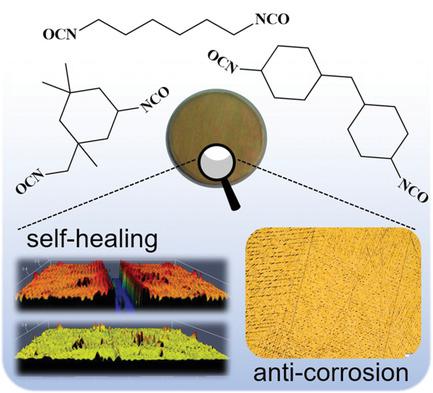当前位置:
X-MOL 学术
›
Adv. Mater. Interfaces
›
论文详情
Our official English website, www.x-mol.net, welcomes your
feedback! (Note: you will need to create a separate account there.)
Role of Diisocyanate Structure on Self-Healing and Anticorrosion Properties of Waterborne Polyurethane Coatings
Advanced Materials Interfaces ( IF 4.3 ) Pub Date : 2021-03-18 , DOI: 10.1002/admi.202100117 Changjiang Yu 1 , Martina Salzano de Luna 2, 3 , Andrea Russo 2 , Ignazio Adamiano 2 , Fabio Scherillo 2 , Zhanhua Wang 1 , Xi Zhang 1 , Hesheng Xia 1 , Marino Lavorgna 3
Advanced Materials Interfaces ( IF 4.3 ) Pub Date : 2021-03-18 , DOI: 10.1002/admi.202100117 Changjiang Yu 1 , Martina Salzano de Luna 2, 3 , Andrea Russo 2 , Ignazio Adamiano 2 , Fabio Scherillo 2 , Zhanhua Wang 1 , Xi Zhang 1 , Hesheng Xia 1 , Marino Lavorgna 3
Affiliation

|
Organic coatings are extensively investigated as possible solution to prevent or at least retard the occurring of corrosion processes on metal surfaces. Their actual breakthrough is still hampered by the risk of barrier properties loss because of local failure of the coating integrity. To address this issue, self-healing coatings, which are intrinsically able to recover from damages upon exposure to external stimuli, are currently gaining increasing attention. Herein, waterborne polyurethanes (PU) are synthesized, and a Diels–Alder adduct is added into the polymeric backbone to endow the material with self-healing functionality. The effect of different diisocyanate in PU synthesis is explored, namely isophorone diisocyanate, 4,4′-dicyclohexylmethane diisocyanate (HMDI), and hexamethylene diisocyanate. The obtained results highlight the key role of the interactions among soft and hard segments in ultimately defining the coating performances. Actually, the combination of Fourier transform infrared spectroscopy, atomic force microscopy and X-ray diffration analysis reveals that the HMDI-based PU have showed the best balance in terms of H-bonding strength among hard segments and crystallinity degree in the soft ones. This allows to reach a good compromise in terms of mechanical resistance, anticorrosion properties, and self-healing ability.
中文翻译:

二异氰酸酯结构对水性聚氨酯涂料自修复和耐腐蚀性能的作用
对有机涂层作为可能的解决方案进行了广泛的研究,以防止或至少阻止金属表面腐蚀过程的发生。由于涂料完整性的局部失效,阻隔性能丧失的风险仍然阻碍了它们的实际突破。为了解决这个问题,自愈涂层本质上能够在暴露于外部刺激后从损伤中恢复,因此越来越受到关注。在此,合成了水性聚氨酯(PU),并在聚合物主链中添加了Diels-Alder加合物,使该材料具有自修复功能。探索了不同的二异氰酸酯在PU合成中的作用,即异佛尔酮二异氰酸酯,4,4'-二环己基甲烷二异氰酸酯(HMDI)和六亚甲基二异氰酸酯。获得的结果突出了软链段和硬链段之间的相互作用在最终定义涂层性能中的关键作用。实际上,傅立叶变换红外光谱,原子力显微镜和X射线衍射分析的结合表明,基于HMDI的PU在硬链段中的H键强度和软链段的结晶度方面表现出最佳的平衡。这允许在机械阻力,抗腐蚀性能和自愈能力方面达成良好的折衷。原子力显微镜和X射线衍射分析表明,基于HMDI的PU在硬链段中的H键结合强度和软链段的结晶度方面表现出最佳的平衡。这允许在机械阻力,抗腐蚀性能和自愈能力方面达成良好的折衷。原子力显微镜和X射线衍射分析表明,基于HMDI的PU在硬链段中的H键结合强度和软链段的结晶度方面表现出最佳的平衡。这允许在机械阻力,抗腐蚀性能和自愈能力方面达成良好的折衷。
更新日期:2021-05-25
中文翻译:

二异氰酸酯结构对水性聚氨酯涂料自修复和耐腐蚀性能的作用
对有机涂层作为可能的解决方案进行了广泛的研究,以防止或至少阻止金属表面腐蚀过程的发生。由于涂料完整性的局部失效,阻隔性能丧失的风险仍然阻碍了它们的实际突破。为了解决这个问题,自愈涂层本质上能够在暴露于外部刺激后从损伤中恢复,因此越来越受到关注。在此,合成了水性聚氨酯(PU),并在聚合物主链中添加了Diels-Alder加合物,使该材料具有自修复功能。探索了不同的二异氰酸酯在PU合成中的作用,即异佛尔酮二异氰酸酯,4,4'-二环己基甲烷二异氰酸酯(HMDI)和六亚甲基二异氰酸酯。获得的结果突出了软链段和硬链段之间的相互作用在最终定义涂层性能中的关键作用。实际上,傅立叶变换红外光谱,原子力显微镜和X射线衍射分析的结合表明,基于HMDI的PU在硬链段中的H键强度和软链段的结晶度方面表现出最佳的平衡。这允许在机械阻力,抗腐蚀性能和自愈能力方面达成良好的折衷。原子力显微镜和X射线衍射分析表明,基于HMDI的PU在硬链段中的H键结合强度和软链段的结晶度方面表现出最佳的平衡。这允许在机械阻力,抗腐蚀性能和自愈能力方面达成良好的折衷。原子力显微镜和X射线衍射分析表明,基于HMDI的PU在硬链段中的H键结合强度和软链段的结晶度方面表现出最佳的平衡。这允许在机械阻力,抗腐蚀性能和自愈能力方面达成良好的折衷。

































 京公网安备 11010802027423号
京公网安备 11010802027423号